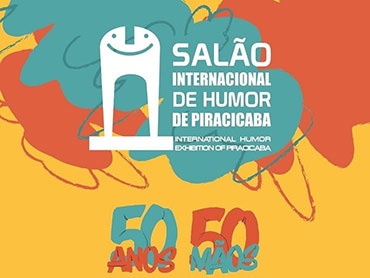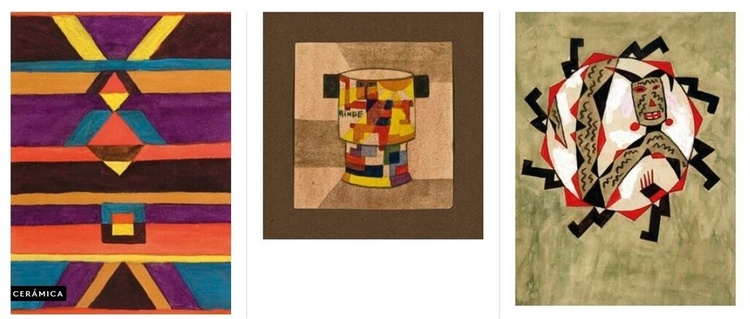
The Major Exhibition "Before America" in Madrid
Xul Solar and the Pre-Columbian Universe: His "Journey to the Seed"
The curator of the major exhibition "Before America" in Madrid tells how Xul Solar began his aesthetic quest in indigenous Latin American art.
Among other mythological references, the artist experienced an intense Americanist period, coinciding with the First World War.
The celebration of the Centennial of Independence across the continent triggered a search for local roots in many artists.
In the exhibition "Before America. Native Sources in Modern Culture" (Juan March Foundation, Madrid, October 2023-March 2024), we include three works by Xul Solar: "Tapestry," "Rinde," and "Mandalas." In selecting works for this exhibition, we were guided, among other goals, by showcasing works by artists with a sustained history of pre-Columbian art influence, but also by those who—such as Xul Solar—showed admiration for these currents and captured that influence in some of their works.
This also gave us the opportunity to view Xul from a different perspective, placing these works in dialogue with those of other artists from the continent who felt the same attraction to the American past.
Xul Solar is a versatile and multifaceted artist—studies such as those conducted by researchers Patricia Artundo, among others, attest to this—a significantly modern artist who knew how to find in the original American sources specific paths to resolve the eternal obsession represented by the search for a cultural identity for the continent. This "Americanist" praxis integrates with the studies Xul Solar conducted on other ancient civilizations worldwide.
The inclusion, in his distinctive iconographies, of geometric abstractions (the case of "Tapestry" is relevant in this regard, which is why we requested it for "Before America"), masks, sacred animals such as snakes, deities, and other elements evocative of ancient civilizations speak to us of that civilization.
It is no small fact that Xul Solar's works, in this Americanist vein, focus particularly on the period 1915-1930. These were years in which the Centennial celebrations and their resulting cultural assessments, after a century of the continent's political emancipation, led to a deeper introspective look, with special attention to the past.
This "journey to the seed" (as Cuban novelist Alejo Carpentier would say) would be accentuated at the time of the First World War, which would mark the crisis of the until then untouchable European cultural model.
In the art world, the growth experienced by schools of arts and crafts and the so-called "applied arts" (textiles, ceramics, furniture, graphic design, stage design, among other disciplines) led, in Argentina, to the celebration of the First National Salon of Decorative Arts in 1918, with a significant and distinguished participation of contemporary artists.
If we consider the dates, works such as the aforementioned "Tapestry" (1918) and "Rinde" (1919)—the latter representing a small vase with a geometric human figure under the sun in its center, and a purely abstract composition at the base—could be understood within this new spirit of the times, marked by the construction of a modernity with its own roots.
Rodrigo Gutiérrez Viñuales is an art historian. He curated the exhibition "Before America. Original Sources in Modern Culture" at the Fundación March, Madrid 2023. He is a professor at the University of Granada. He is a member of the National Academy of History and the National Academy of Fine Arts (Argentina).
Source

- November 21, 2025
Jorge Luis Alvarez Pupo | Sports Photography | Cuba

- November 21, 2025
Havana Still(s) | Damaris Betancourt – Cuba
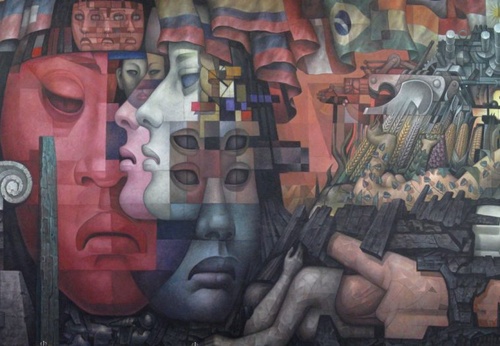
- November 20, 2025
The Evolution of Modernism in Latin America
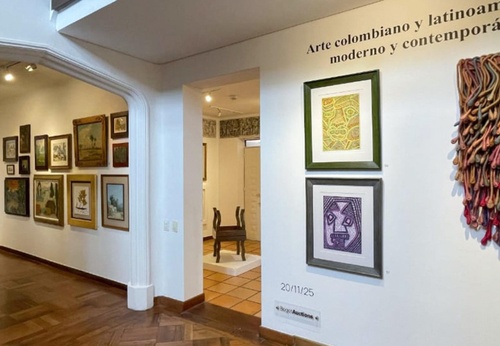
- November 20, 2025
An auction in Bogotá
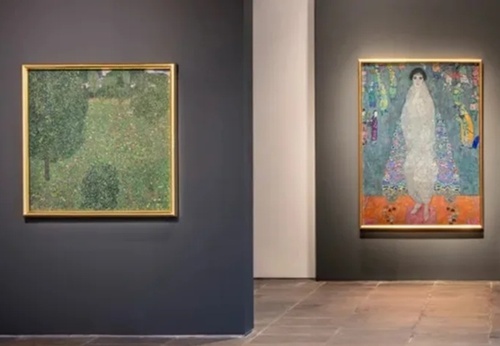
- November 20, 2025
Klimt Breaks Record at Sotheby’s

- November 20, 2025
GAZA FLOOD BLOOD THEN FLOOD

- November 20, 2025
MBS is a guest of Trump
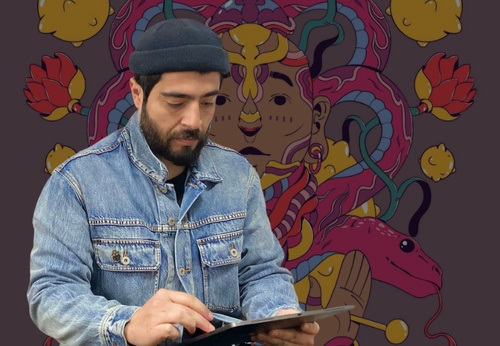
- November 20, 2025
José Elgueta - Chile

- November 19, 2025
Gallery of Illustration by Jose Elgueta – Chile

- November 20, 2025
An auction in Bogotá

- November 20, 2025
Klimt Breaks Record at Sotheby’s

- November 19, 2025
Pinta Miami celebrates its 19th edition…

- November 18, 2025
Artists and galleries from Brazil and L…

- November 17, 2025
"Painting in Mexico Today Is More Alive…

- November 17, 2025
Paris Photo Exhibits Iconic Collection …

- November 16, 2025
Art Exhibition in Bogotá

- November 15, 2025
Frida Kahlo's 'The Dream (The Bed)' Exp…

- November 12, 2025
Brescia, an exhibition of works by the …

- November 12, 2025
Uruguayan Artist Joaquín Torres García …

- November 11, 2025
Painting in Mexico Today Is More Alive …

- November 11, 2025
Oaxacan School Dominates Latin American…

- November 10, 2025
Artweek 2025 Celebrates a Decade of Art…

- November 10, 2025
Pop Brasil Arrives at Malba with Over 1…

- November 10, 2025
Adriana Cisneros Pays Tribute to Latin …

- November 10, 2025
Mira Art Fair 2025

- November 09, 2025
MIRA Art Fair 2025: Latin American Art …

- November 09, 2025
The Influence of Renaissance Art on Mod…

- November 06, 2025
Experience the vibrant pulse of Latin A…

- November 06, 2025
The Ministry of Culture invites you to …

- October 08, 2023
Illustrations reflect the brutal Israel…

- December 25, 2023
The jury statement of the Iran-Brazil F…

- July 29, 2023
History of Caricature in Brazil

- May 22, 2025
Brady Izquierdo’s Personal Exhibition O…

- March 21, 2024
The history of art in Palestine

- September 01, 2023
Neural Filters in new photoshop 2023

- April 20, 2024
Poignant Image of Grief Wins Mohammed S…

- June 29, 2024
Exhibition at Centro MariAntonia contra…

- October 21, 2023
Erick Meyenberg and Tania Ragasol at th…

- May 15, 2024
Eleven murals for Gaza painted across t…

- February 18, 2024
7 Ways to Understand What Visual Arts A…

- August 09, 2023
Venezuela mural expresses solidarity wi…

- March 14, 2024
museum of statue of van gogh

- March 15, 2024
museum of sculpture of Salvador Dali

- May 20, 2024
Latin American Festival of Performing A…

- May 25, 2025
Bordalo II to hold exhibition in Paris …

- March 30, 2024
illustration websites in Latin America

- October 23, 2023
Photos by José Luis Díaz of the march o…

- May 27, 2025
Works by Botero, Grau, and 80 other imp…

- December 01, 2023
Latin American International Graffiti F…

- May 15, 2024
Eleven murals for Gaza painted across t…

- February 18, 2024
7 Ways to Understand What Visual Arts A…

- January 02, 2025
13 commemorations that will mark the cu…

- October 17, 2023
The influence of Latin American artists…

- February 03, 2024
THE HISTORY OF NAIF ART

- October 08, 2023
Illustrations reflect the brutal Israel…

- July 02, 2024
One of the largest urban art galleries …

- November 17, 2023
Fernando Botero's work is booming after…

- July 29, 2023
Piracicaba International Humor Exhibiti…

- November 06, 2023
Heba Zagout: Palestinian artist murdere…

- December 25, 2023
The jury statement of the Iran-Brazil F…

- December 10, 2023
Sliman Mansour and Palestinian art on t…

- February 01, 2025
A maior exposição de Botero em Barcelona

- March 14, 2024
museum of statue of van gogh

- March 21, 2024
The history of art in Palestine

- July 20, 2024
First International Mail Art Biennial 2…

- April 20, 2024
Poignant Image of Grief Wins Mohammed S…

- October 30, 2023
Palestinian turns images of the Gaza co…

- September 01, 2023
Neural Filters in new photoshop 2023

- February 06, 2024

